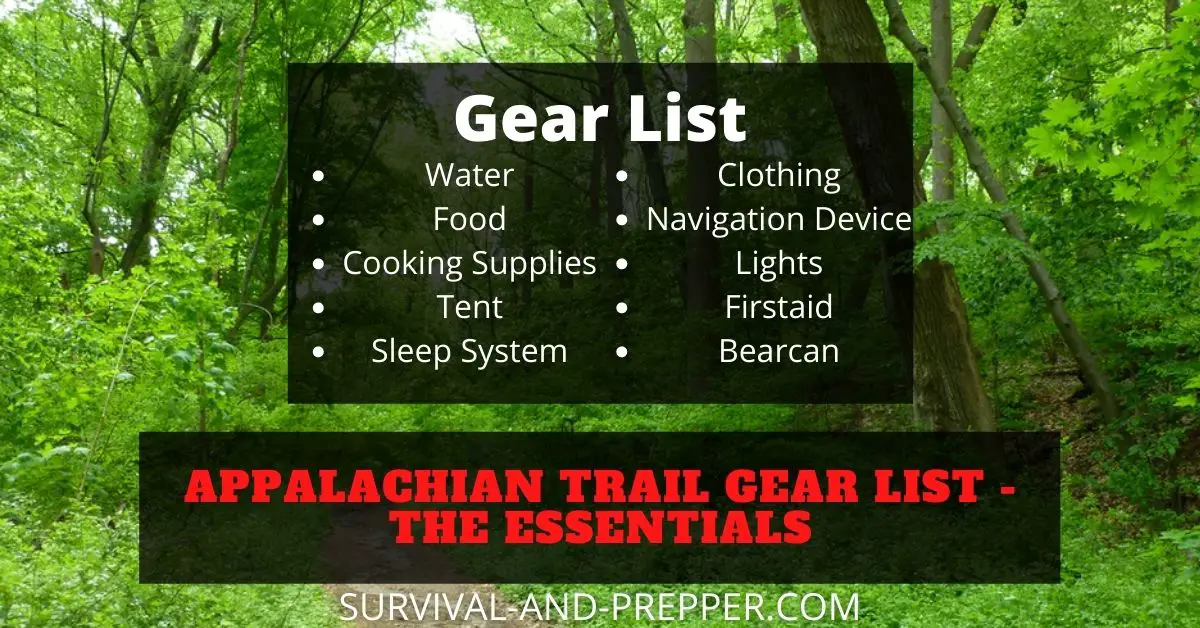Appalachian Trail Gear List – The essentials
The headline of “Appalachian Trail Gear List” may lead some of you to wonder why I am posting about a hiking trail on a survivalist site. Well I figure that many of the skills needed to accomplish this task will be similar. It will give you a way to test your bug-out kit. As well as building a shelter and your endurance which could give you an idea how you will survive in a real emergency.
One of the down sides though is you will need to carry enough food with you for four to five days. While possible it is generally not considered feasible to fish and hunt along the trail. This stems from several several issues. The first being hunting and fishing regulations differ by state and in order to be legally compliant you would need a license in each state that you were going to hunt or fish in. The next issue is that these activities frequently take large amounts of your time and you cant make much distance if you are trying to catch your dinner. I feel that an extended hike on the Appalachian Trail is an excellent chance to test out your bug-out bag though.
On a side note it is recommended that you do not carry a firearm on the trail. This again stems from potential legal issues of concealed permits and reciprocity etc.
A great Appalachian Trail Gear list, just like a bug-out bag starts with determining how long you plan to be on the route. You also need to decide if you are going alone or with someone else. Given the extreme nature of the trail it is recommended that you go with at least one other person, however that is not always possible.
Considerations
The general principles behind a bug-out bag and a long distance hiking kit can be similar. A bug-out bag is intended to give you everything you need to get out of an area and reach a new location. It is not designed to support you long into the future, but only to provide a base. In the case of a long distance hiking kit the same thing is desirable. Enough supplies to enable you to travel from point A to point B are needed as well.
In both cases you will not generally be able to spare the time to hunt or gather food along the way as frequently time is of the essence. In a hiking long distance hike you are trying to reach a specific distance in a certain amount of time. While in the case of a bug-out you are racing to your place of safety as everything has come apart. So it will be necessary to carry all of your food supplies and water with you, if you cant carry it all then you will need planned resupply locations. These can be strategic caches along the planned way or other known locations that you can resupply.
The next factor to consider is weight, you want to minimize the weight you are carrying if at all possible. This will allow you to move both faster and further. For every bit of extra weight you carry that is more energy you will need to expend.
Now for the Appalachian Trail Gear
Your Appalachian Trail Gear list should contain at a minimum the following items:
Tent
Even though there are shelters available you should pack your own tent. There are times when you may find yourself unable to make it to the next shelter or discover that the shelter is full. This is a must have. Though you can make do with at a minimum of a tarp there are some very good tents that are light weight.
Food
As mentioned above you will want to carry enough food for four or five days. In most cases you should be able to resupply in nearby towns every three or four days, however this will depend on your progress. If you are new to long distance hiking then I suggest carrying more food at the beginning until you get a feel for what you will need. I also suggest considering some light weight options, such as dehydrated meals or something like oatmeal, grits, or Ramen noodles. These options will eliminate some of your weight by not having water in them.
Other Options include trail mix, jerky, combos, cheezits, peanut butter crackers, granola bars, breakfast bars, fruit snacks, salmon packs, canned chicken, Pop Tarts, pastries, peanut butter, tortillas, summer sausage, jerky, candy, drink mixes. Just remember to keep weight in mind.
What Thru-Hikers Eat on the Appalachian Trail
Water
Obviously water is a critical need. However, water also happens to be one of the heaviest things to carry with a single liter of water weighing about 2.2 lbs. While there are not frequent pipes to obtain water from there are plenty of natural sources of water. Keep in mind that these may or may not contain bacteria and you should consider options to treat your water.
Take care in considering your primary water container. While many people seem to like the Camelback style water pouches that fit into your backpack they have a few issues. The first being refilling them can be tedious when the only source of water is a stream. Then there is the issue of filtering the water. While some of the newer ones have filters built into the straws these can be very expensive. A better option is using two 1 liter bottles with at least one of them having a built in filter.
You can also treat water by other means as found in the two articles below. To avoid carrying more than you need make sure to drink nearly a full bottle when you are refilling your water. This will allow you to carry less. Also keep tabs on the weather mainly in PA as water sources tend to run dry there in the late summer.
Treating Water on the Applachian Trail
Six ways to purify water in a survival situation
Clothing
What clothes should you pack for your thru-hike? You will need to consider clothing with care, while necessary it does add considerable weight. The first priority is your shoes. While hiking boots are fairly common most thru-hikers recommend mesh trail runners. These hold less water than boots and tend to be far lighter. Consider the fact that you will likely need to replace your shoes mid hike if doing the full trail. It is estimated that a decent shoe should last 400 to 500 miles.
Socks are another critical component. Obviously you want socks that fit well and are moisture wicking. I suggest carrying enough socks so that you can be certain you have a dry pair while the others are drying.
Rain Gear and a light jacket are also strongly suggested. It is not uncommon to encounter a rain storm along the trail. Temperature swings can leave you wishing that you had a jacket, it is possible to make a selection here that meets both needs.
Last is your actual outfit, this needs to be durable and comfortable. Keep in mind you will be wearing this nearly every day for several weeks or more. In addition to this outfit you may want a second outfit for wear around the camp site, or to go into town as you don’t want to wear your dirty clothes into town.
Clothing for an Appalachian Trail Hike
Sleep System
What sleeping bag and pad should you pack for your thru-hike? Your sleep system should ideally include a sleeping mat and a sleeping bag. Use care here as a good nights sleep can make all the difference. You have the option of a mat or a hammock style sleep system, though if you choose the latter make sure you are comfortable sleeping in one before you begin your trek. One option that is becoming more popular is the hammock tent combo systems, these ensure that you are above any rain that may puddle and ruin your nights sleep.
Keep in mind that a waterproof option would be beneficial just in case your shelter leaks or your unable to get it set up.
Light, First Aid, and Navigation
These things should be obvious but you will likely need a source of light for night time activities. You want to make sure to have more than one light and spare batteries, a headlamp is a great choice as it allows you to keep your hands free.
Maps and or a GPS are critical to ensure that you don’t loose your way. There are a few places where it may be difficult to locate the trail markers and having a GPS to assist you will be huge. In today’s time you can get GPS devices that also include a personal locator beacon that can summon help to your exact location and may be worth the extra money.
First Aid at a minimum you should have supplies to treat blisters. Keep in mind though that it may be likely that any medical assistance is hours away at best. You should include stuff to handle minor sprains, broken bones and puncture wounds. Also consider some upset stomach medication and possibly ibuprofen or similar. A roll of duct tape is also an essential item, it can be used for splints in a pinch or to patch gear and is worth the weight.
Cooking Option
How will you cook your food on an Appalachian Trail thru-hike? You will most likely want a stove of some sort for cooking your food. Many areas along the Appalachian trail do not allow camp fires. As such many hikers prefer to carry an alcohol based system or a canister stove. If you choose one of these types of stoves make sure that you select food that compliments its cook style.
Bear Can
Obviously wildlife along the trail can be quite diverse. Some of the wildlife you will encounter include, squirrels, rabbits, snakes and even bears. As such you need to make sure you protect your food supplies from them and one the best ways to do so is with a bear can. Many locations now require bear cans. This is because the old method of hanging your food from a tree is not as reliable as many would have you believe. Bear cans come in a variety of sizes and weights. You should examine several different brands and styles. This will allow you to get one that suits your needs. Make sure it fits your pack and equipment.
Backpack
The item and perhaps one of the most important questions is what kind of backpack should I use for the Appalachian Trail. Obviously this is always a matter of your preference. Organizations such as the military frequently use large packs with frames on them. Some will argue that these are more comfortable. However, you must remember that these frames add extra weight as well. Most thru-hikers that I have spoken with actually recommend that you do not use the backpacks on frames as every ounce counts in the long run. Some common suggestions were Granite Gear Crown2, Osprey Aether AG70, and the Teton Sports Scout 3400. (The links are to amazon and I have not personally tried any of those, though I plan to purchase the Teton Sports Scout in the near future.)
The items you need on an Appalachian thru-hike include:
- Water – 2 to 3 liters plus filtration plan
- Food – 3 to 4 days at a minimum
- Cooking supplies – Alcohol Stove recommended
- Tent – Lightweight Easy to set up
- Sleep System – Bag and Pad or Hammock
- Clothing – To include Rain Gear
- Maps and Navigation materials – GPS/Personal Locator Beacon
- Light Source – flashlight, headlamp
- First Aid Supplies – Blisters, basic injury
- Bear Can – Required in some areas, check if you need
- Backpack – Lightweight and capable of carrying all of these supplies
So that completes our list of items for a thru-hike on the Appalachian trail. As I explained many of these are very similar to items that you might carry in your bug-out bag. By evaluating your bag against some of these requirements you can make adjustments and then even test out your gear on a shorter trip.
I look forward to seeing you on the trails, and as always stay prepared and stay safe.
Check out our other articles including:







Like!! Thank you for publishing this awesome article.